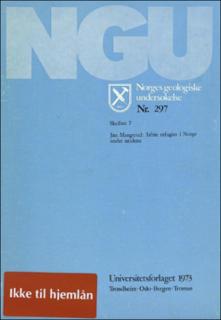| dc.contributor.author | Mangerud, Jan | |
| dc.date.accessioned | 2020-08-26T13:11:04Z | |
| dc.date.available | 2020-08-26T13:11:04Z | |
| dc.date.issued | 1973 | |
| dc.identifier.uri | https://hdl.handle.net/11250/2674963 | |
| dc.description.abstract | A review is given of the historical development of the theory of unglaciated refugia in Norway. The phyto-geographical and geological arguments for and against the theory are discussed, and our knowledge of the ice-borders during the Late Weichselian maximum is summarized. The refugia-theory is also discussed in relation to recent results concerning the stratigraphy of the Last Glaciation (Weichselian), including the possibility that parts of Scandinavia were deglaciated during some interstadials. The author emphasizes that the problem is not solved, but his intuitive conclusion is that Scandinavia was completely covered by ice, and that the alpine plants immigrated after the Late Weichselian maximum. | |
| dc.language.iso | nor | |
| dc.relation.ispartofseries | NGU; Skrifter (297; 7) | |
| dc.rights | Navngivelse 4.0 Internasjonal | |
| dc.rights.uri | http://creativecommons.org/licenses/by/4.0/deed.no | |
| dc.subject | PLANTEGRUPPE | |
| dc.subject | GLASIALGEOLOGI | |
| dc.subject | GEOKRONOLOGI | |
| dc.subject | KLIMA | |
| dc.title | Isfrie refugier i Norge under istiden. | |
| dc.type | Journal article | |
| dc.description.localcode | 36298 | |
| dc.source.pagenumber | 1-23 | |

